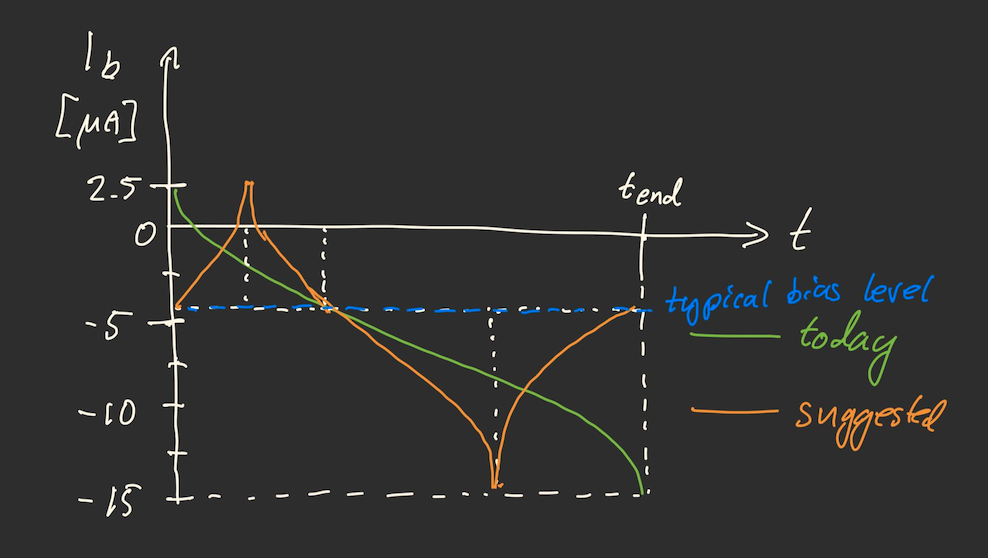| Item | Notes |
|---|
Overview of the anomaly status (Xavier Bonnin) | |
| Analysis report concerning HF PA electronics as a possible root cause (Emmanuel Guilhem, Moustapha Dekkali and Pierre-Luc Astier) | - Presentation by Emmanuel Guilhem (EG) from his email on April 2, 2024 (see copy in CNES_EG_HF_PA_analysis_20240402.pdf attached below)
- Presentation by Moustapha (MD) and Pierre-Luc (PL) from PL simulation results (see figures in Antenna 3 failure HF preamplifier latch up hypothesis.pdf attached below)
- Walter Puccio (WP) found 25 Ohms for the short cut resistor. EG found 60 Ohms.
- Short potential value is close to 4V
- HV transients during Bias sweeps are very "hard" (especially at start and end). We should "smooth" the sweep. Anders Eriksson (AE) proposes a new Bias sweep profile to be loaded on-board using a new table (see "CAD drawing" PNG attached below. file Screenshot 2024-04-03 at 16.05.01.png)
- EG notifies there is a risk of overating of ST404 and the JFET AD 8001 transistors in the HF PA electronics during sweeps. A test could be to perform sweep with HF PA OFF
- According to Bias team, if the short is due to HF PA only, we should not see it on the DC part
- Simulations from PL show no overating of HF PA components with current usage of Bias on-board.
- PL thinks is not a good idea to run Bias sweeps with HF PA OFF because PA-related HK data acquired will be not relevant
- Do we turn off at least HF PA during ANT3 sweeps? For MD it is not obvious that it will prevent PA from damages so it would be preferable to keep it ON (to monitor equipement)
- For THR and Bias teams, the anomaly does not come from HF PA. Most probable root cause should be still a "ground" element in contact with the antenna
|
| General discussions | - Discussions about candidates for "ground" element:
- SLI added on-ground by CNES and STELLAR in ANT2 and ANT3 to avoid unexpected reflexion from SA (avoid hotspot). (see also in RPW commissioning report). Issue with glue? Does the SA illuminations could heat the glue? Problably not, but properties should be checked (especially from thermal point of view). Glue applied on already-placed MLI. No test done. Eric will send photos + documentation on glue used to Xavier. If the SLI is not in place anymore, we might see hotspots from SA. It is the case? Chris will check.
- Could be also a "stacer", PA MLI or "doors" open during deployement. Manoeuvers (like rolls) could impact the position of these doors. What it is the closest distance between "ground" element and the ANT? Milan and Xavier will contact STELLAR team for a discussion and invite them to the ARB.
- Xavier shows example in SoloHI image (see last slide in "ROC_telecon_ANT3_20230403.pdf" file). Curves lines are observed. Could be heatshield "debris" according to Anik.
|
| Conclusions & next steps | HF PA electronics should not be a root cause for ANT3 anomaly But, to avoid possible damage in HF PA (especially in ANT3) it is recommended to « smooth » Bias sweeps (see proposal by Anders) This "smooth" bias sweeps will be implemented on board using TC LOAD SWEEP TABLE (Diane will create a new sequence from Bias team input) In addition, next Bias sweeps should be cancelled as long as ANT3 is not disabled by the new sweep sequence (AIWF033T should be ready for mid-April / STP305) - ARB is planned on April 26 at 9:30AM (CEST) by Webex
- A first issue of the RPW anomaly report (including the list of periods where the ANT3 was failed) will be released by LESIA before the ARB
|
